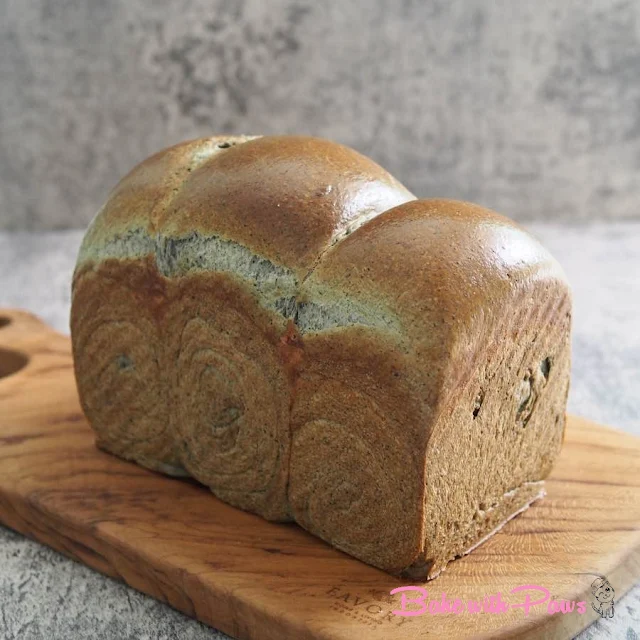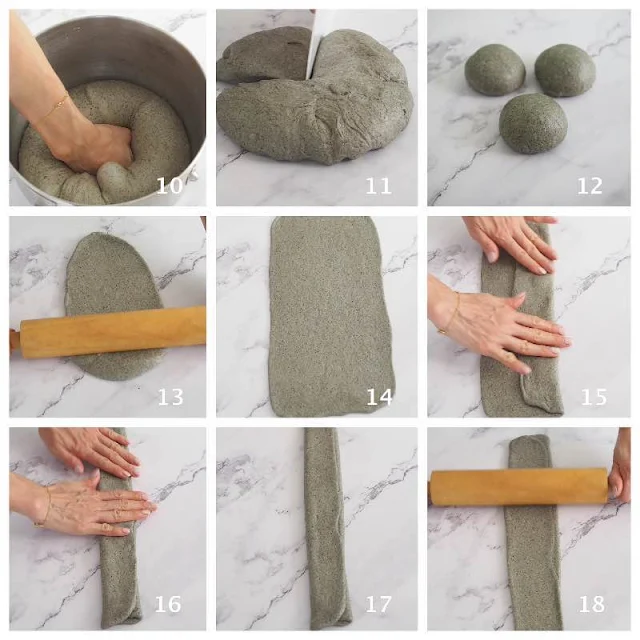Breads (Yeast) - Loaves
Black Sesame Bread
July 18, 2017
| Recipe by Bake with Paws
Scroll to the bottom of the page for "PRINT RECIPE" ⬇
I rebaked this Black Sesame Bread (5 Thousand Dollars Starter Dough Bread Recipe) that I shared before. I modified it into an old dough method instead of my usual preparation of pre-fermented dough one day before for use the next morning. The bread turned out very soft and fluffy. I would readily recommend this as a must try recipe for anyone who loves to bake.
If you have any questions regarding this recipe or any other post, please leave me a comment in the “LEAVE A COMMENT” link and I will reply you as soon as possible. Do tag me on Instagram @Bakewithpaws if you attempt on this recipe.
How To Make Black Sesame Bread/Loaf
Yields: 1 loaf
INGREDIENTS:
Old Dough:
165g bread flour (I used Japan High Gluten Flour)
110g water
1/4 round tsp (1.5g) instant dry yeast
1/4 round tsp (2g) sugar
Main Dough:
165g bread flour (I used Japan High Gluten Flour)
45g black sesame seed (toasted and blended till become a paste)
All the old dough
20g - 40g sugar (I used 20g)
1/4 round tsp (1.8g) instant dry yeast
1 tsp (5g) salt
45g egg, whisked (from 1 egg)
70g milk (reserve 10g and add in later if needed) I used 70g *
40g butter, room temperature
Egg Wash:
1 egg + 1 Tbsp water
Utensil:
450g loaf pan (21.3 X 12.2 X 11.5 cm / 8.4" X 4.8" X 4.5")
The total amount of water is very much depend on your flour, because each flour absorbs liquid and hydrates differently. You may also add 1 teaspoon of milk at a time during kneading if the dough is too dry, when you see that the dough doesn't stick to the bottom at all. We want the dough to clear from the sides of the bowl with only a small part of the bottom sticking to the base of the mixer bowl. You should hear a slapping sound of the dough hitting the sides of the mixer bowl.
METHOD:
- Old Dough
- Dissolve instant yeast, sugar and water in a bowl. Add in flours and mix with hand until well combined. You may also use stand mixer. Roll into a ball and place in a greased bowl. Cover with cling film and let it proof 1 hour in room temperature (28C - 29C).
- After 1 hour, place into the refrigerator overnight for at least 12 hours or up to 16 hours. Fridge temperature 2C - 4C. The next morning, take out the old dough from refrigerator to return to room temperature 30 minutes before using. You can also use directly from the fridge if you forget to take out earlier.
- If you don't plan to bake the next day, after 1 hour fermentation, shape it into a ball and wrap it in cling wrap or place it in a ziplock bag. Store it in the freezer for 1-2 months. Take it out 30 minutes before using to defrost.
- Main Dough:
- Put all ingredients (except butter) into a bowl of stand mixer. Using the paddle attachment, mix for around 2 minutes or until all incorporated. Change to hook attachment and knead for another 3 minutes or until the dough comes together and elastic. Add in butter and continue knead for about 12 minutes or until reach window pane stage. During the whole kneading process, I stopped few times to scrape down the dough from the hook to be sure it is evenly kneaded and also to prevent the motor from overheating.
- Round up the dough and put back in the same bowl. Cover with lid and let the dough rise in a warm place for 45 to 60 minutes or until double in size.
- Shaping:
- Punch down the dough to release the air. Transfer the dough to a clean floured or oiled surface then divide into 3 equal portions (around 219g per portion)
- Preshape the dough into rough ball. Rest for 5 minutes.
- Flatten with rolling pin.
- Fold right to centre and fold left overlap it. Roll out with rolling pin into long rectangle shape. Roll up the dough like Swiss Roll until a small log is formed.
- Place all dough in the prepared loaf pan.
- 2nd Proofing:
- Let it rise at warm place (my room temperature around 28C) for another 45 - 60 minutes, or until the dough reaches about 1 cm below the rim of the pan.
- To bake:
- Preheat oven at 180C - 190C (top & bottom heat) or 160C - 170C (fan-forced) for 15 minutes before baking.
- Brush with egg wash.
- Bake in a preheated oven for about 30 minutes, or until golden brown. If it is browning too quickly, cover the top loosely with aluminium foil.
- Remove bread from oven then remove the bread from the pan. Let it cool on rack completely before slicing.
Old Dough
Main Dough
GENERAL NOTES:
GLUTEN DEVELOPMENT & WINDOWPANE TEST
Gluten forms when flour comes in contact with water. Hydration of the flour causes the sticky and stretchy protein to form, giving structure to the bread. This makes your bread trap air and rise.
Gluten in dough can be developed by autolyse, resting, kneading or folding.
The windowpane test is used to determine whether the dough has been sufficiently kneaded. By gently pulling the dough (or you may pinch off some dough) and trying to stretch it into a thin membrane. If you are able to stretch the dough paper thin and translucent without tearing, then the gluten is fully developed. However, if you can stretch it without tearing but the membrane is not transparent, then the gluten is not yet fully developed.
However, from my experience not all the recipe can achieve a thin and translucent window pane stage easily. For example low hydration and low fat dough. For such recipes, a reasonable window pane is good enough and it can be left to rest. Gluten will continue to develop while resting. Exercising restraint to not over-knead the dough prevents the gluten from being overworked and broken. Some of you may have experienced the dough breaking during the second proofing. It is because the dough is over kneaded.
The total kneading time for me is usually 15 minutes at low speeds except brioche dough with high fat percentage or dough using liquid fat which usually takes a little longer (maybe 18-20 mins).
From my experience, I found that high hydration dough with high percentage of fat will be easy to stretch and achieve a paper thin windowpane stage.
KNEADING TIME
For kneading, please regard the timing provided as an indication only. It is only meant as a guide. Timing may differ depending on the brand of flour and electric mixer used. The protein content may vary from one brand of flour to another.
FLOUR
The right flour plays a very important role in bread making. To achieve fluffy, soft and light bread, I used Japan High Gluten Flour in most of my bread baking. The protein content is around 12 - 13%.
HYDRATION
The liquid measurement given is also a guide. It is advisable to always reserve some liquid and not add it all in one go. This would give you the opportunity to adjust if necessary. If dough is too dry, add the reserve liquid one tablespoon at a time until the right consistency. This is because each flour absorbs water and hydrates differently.
PROOFING
Please note that the proofing timing may also vary depending on your climate and environment. The humidity and temperature at your place will influence how dough rises.
If you are unable to judge by just looking at the dough, you can do the finger poke test:
- First Proofing:
- Lightly flour or oil your finger or knuckle, gently poke in the centre of the dough then remove your finger. If it bounces back immediately without any indentation then it needs more time.
- If the indentation stays and it doesn’t bounce back or if the dough collapses, then the it is over proved.
- If it bounces back just a little, then the dough is ready to be punched down and shaping.
- Second Proofing:
- Lightly press the side of the proved dough with your finger. If it bounces back immediately without any indentation, it means the dough is under proved and needs more time before baking.
- If the indentation stays and it doesn’t bounce back, it means it has been over proved.
- If the indentation slowly bounces back and leave a small indentation, it is ready to bake.
- There will be a final burst of rising once the bread is placed to bake in the oven and it is called oven spring.
WRINKLE TOP OR SHRINKING
If your bread collapses or gets wrinkled on top after removing from oven, it could be because your dough over proved during the second proofing. Please proof until it rises 80 - 90% in size or is slightly below the rim of the pan.
BAKING TEMPERATURE & TIME
Do also note that the baking temperature and timing provided are what works for my oven and should also be regarded as a guide only. Every oven behaves a little differently, so please adjust accordingly for your oven.
Archived Picture
Labels:
Breads (Yeast) - Loaves,








Hello. Just wondering if I can use sourdough starter to replace the 6g of instant yeast for the sponge dough? If so, how much starter do I use? Thanks :)
ReplyDeleteHi, yes you can. But, there will be alot of changes in the amount ingredients. I need to develop a new recipe and try first.
DeleteHowever, you can try to build 300g of levain to replace sponge dough. I am not sure sure it will work.
You may also use my soft sourdough bread recipe and add in sesame seeds.
Cheers:)
Hi can I ask whether I can use milk/whipping cream instead of water for the sponge dough?
ReplyDeleteHi, thanks for reading. Yes, should be fine for milk. I am not sure about whipping cream. But, should be ok I think.
DeleteCheers :)
Where do l refer for shaping? Thanks.
ReplyDeleteHi, sorry for the missing link. Please refer to the link below:
Deletehttps://www.bakewithpaws.com/2018/01/pandan-chocolate-milk-loaf.html
Cheers :)
May I use premade black sesame powder? And the adjust hydration? Thank you!
ReplyDeleteHi, Thank you for your interest in this recipe. Yes, of course you can. You may or may not need to adjust the hydration depend on the sesame powder that you use. If you feel the dough is too dry or hard than add 1 tsp of water at a time.
DeleteHappy Baking :)
Hi, can I use oatmilk instead of dairy milk?
ReplyDeleteHi, sorry for very late response. Yes, of course you can.
DeleteCheers :)